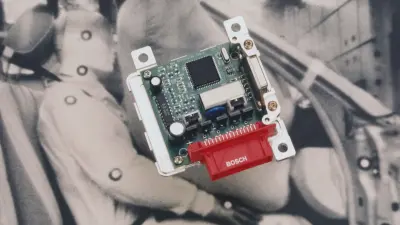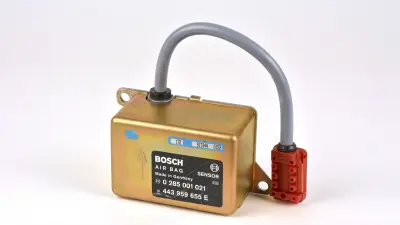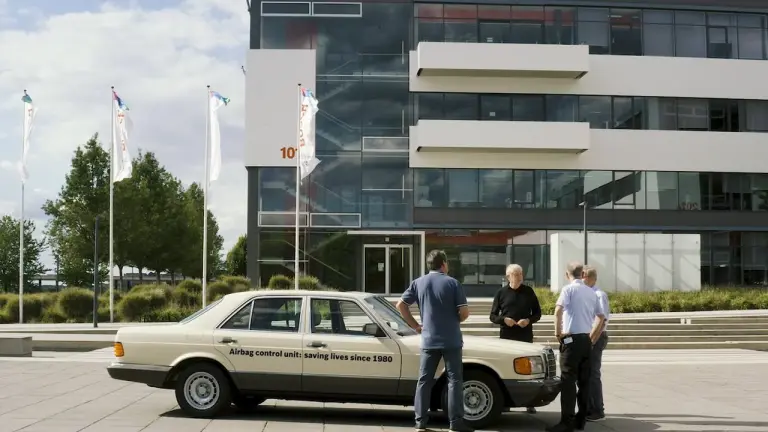The history of airbag control units
Four decades of advancing safety

A kind of inflatable cushion to absorb impact in vehicles — the first ideas for an airbag can be traced back to the early 1950s in Europe and the United States. As roads saw increasing traffic, with a rising number of serious accidents, calls for improved vehicle safety grew more and more urgent.
The U.S. Department of Transportation initiated a first package of laws in 1969 with the aim of requiring safety belts and passive occupant protection systems for all new cars. The plans provided fresh impetus for the airbag idea, especially in conjunction with the possibilities opened up by electronics. Initial attempts to produce a functioning airbag had all failed due to defective sensors and triggering mechanisms.
Newly developed sensors and electronic circuits quickly proved to be highly promising in the years that followed.
A plastic airbag that inflates in milliseconds after the start of a collision marked a major improvement in the protection provided to a vehicle's occupants. In the worst case, when impact is unavoidable, serious consequences and injuries can be mitigated or even prevented altogether. The control unit used to trigger the airbag system plays a crucial role here.
Protection at the right time
A “triggering apparatus for an inflation process in a bag,” for which Bosch applied for a patent in the spring of 1976, marked the first important step in development at the company. One key component of this apparatus was an acceleration sensor that measured the deceleration occurring on impact in relation to time, so the protective airbag was inflated at the right time in accidents with different causes. The sensor could be used to trigger automatic belt tensioners in the same way.
Bosch’s electronic control unit for passive restraint systems went into series production in 1980 and saw its first use in the Mercedes-Benz S-Class in 1981. It had three ignition outputs to trigger a driver airbag and a two-step passenger airbag or the same number of belt tensioners.

The device’s tasks were complex right from the start. Accidents needed to be identified accurately and the severity gauged, and then the airbag and belt tensioner had to be triggered at the right time. The electrical and electronic components were also monitored constantly to prevent improper actuation and display information on the system’s availability and functionality.
Reliable restraint systems

Switch point: control unit
At impact speeds of 15 to 18 km/h or more, the Bosch control unit triggered the actuation of the airbag and belt tensioners. The acceleration sensor and multiple application-specific circuits were used to reliably tell an actual accident apart from a pothole, curb, or a heavy hammer blow in the service station. To collect precise information on the deceleration caused by the impact, the control unit was installed inside the vehicle. This allowed the acceleration sensor to take measurements where passengers were sitting, sending a signal to trigger the device at the crucial split-second.
Further refinements have been added to airbag systems and airbag control units on an ongoing basis since they were first introduced. Combined with a belt and belt tensioner, airbags are the most effective passive safety system in cars. Many countries now require airbags, and around the world, there are hardly any new cars being produced without a driver airbag at least. Advanced airbag control units use various sensors to identify an accident, trigger the respective restraint systems for all of a vehicle’s occupants, and connect the airbag control system to additional safety functions for driver assistance and communication systems.
The latest Bosch airbag control unit, now in its 12th generation, analyzes reports from as many as 18 external acceleration and pressure sensors and controls up to 48 restraints – all while meeting the most stringent requirements at all times. Still, even though airbag systems are always standing by to ensure the safety of all vehicle occupants, it’s best if they never end up being used at all over a vehicle’s lifetime.

Loading the video requires your consent. If you agree by clicking on the Play icon, the video will load and data will be transmitted to Google as well as information will be accessed and stored by Google on your device. Google may be able to link these data or information with existing data.
Looking back, looking ahead: airbag control units from Bosch.
Author: Bettina Simon



